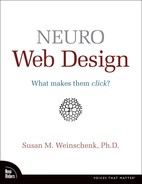Bargh, John A., Mark Chen, Lara Burrows. 1996. Automaticity of social behavior: Direct effects of trait construct and stereotype. Journal of Personality and Social Psychology Vol 71(2), 230-244.
Bechara, A., H. Damasio, D. Tranel, and A.R. Damasio. 1997. Deciding advantageously before knowing advantageous strategy. Science. 275, 1293-1295.
Brady, T.F., T. Konkle, G.A. Alvarez, and A. Oliva. 2008. Visual long-term memory has a massive storage capacity for object details. Proceedings of the National Academy of Sciences, USA. Vol. 105(38), 14325-14329.
Cialdini, R.B., J.E. Vincent, S.K. Lewis, J. Catalan, D. Wheeler, B.L. Darby. 1975. A reciprocal concessions procedure for inducing compliance: The door-in-the-face technique. Journal of Personality and Social Psychology. 31:206-215.
Deutsch, Morton, and Harold B. Gerard. 1955. A study of normative and informational social influences upon individual judgment. The Journal of Abnormal and Social Psychology. Vol 51(3), 629-636.
De Vries, Peter and Ad Pruyn. 2007. Source Salience and the Persuasiveness of Peer Recommendations: The Mediating Role of Social Trust. In Persuasive Technology, Second International Conference on Persuasive Technology. New York: Springer.
Dijksterhuis, A and Z. van Olden. 2005. On the benefits of thinking unconsciously: Unconscious thought can increase post-choice satisfaction. Journal of Experimental and Social Psychology. Vol 42(5), 627-631.
Efran, M.G. and E.W.J. Patterson. 1976. Voters vote beautiful: The effect of physical appearance on a national election. Canadian Journal of Behavioural Science. Vol 6(4), 352-356.
Felfernig, A., G. Friedrich, B. Gula, M. Hitz, T. Kruggel, G. Leitner, R. Melcher, D. Riepan, S. Strauss, E. Teppan, and O. Vitouch. 2007. Persuasive recommendation: Serial position effects in knowledge-based recommender systems. In Persuasive Technology, Second International Conference on Persuasive Technology. New York: Springer.
Fogg, B.J., 2008. Mass interpersonal persuasion: An early view of a new phenomenon. In Persuasive Technology, Third International Conference on Persuasive Technology. New York: Springer.
Freedman, Jonathan L. and Scott C. Fraser. 1966. Compliance without pressure: The foot-in-the-door technique. Journal of Personality and Social Psychology. Vol 4(2), 195-202.
Fogg, B.J. and D. Eckles. 2007. The Behavior Chain for Online Participation: How Successful Web Services Structure Persuasion In Persuasive Technology, Second International Conference on Persuasive Technology. New York: Springer.
Gamberini, Luciano, Giovanni Petrucci, Andrea Spoto, Anna Spagnolli. 2007. Embedded persuasive strategies to obtain visitors’ data: Comparing reward and reciprocity in an amateur, knowledge-based website. In Persuasive Technology, Second International Conference on Persuasive Technology. New York: Springer.
Gunes, Hatice and Massimo Piccardi. 2006. Assessing facial beauty through proportion analysis by image processing and supervised learning. International Journal of Human-Computer Studies. Vol 64(12), 1184-1199.
Hassin, Ran R. 2005. Nonconscious control and implicit working memory. In The New Unconscious, edited by R.R. Hassin, J.S. Uleman and A. Bargh. New York: Oxford University Press.
Heinrich, J.R., S. Boyd, S. Bowles, C. Camerer. E. Fehr, and R. McElreath. 2001. Cooperation, reciprocity and punishment in fifteen small-scale societies. American Economic Review. May 2001.
Iyengar, Sheena S. and Mark R. Lepper. 2000. When choice is demotivating: Can one desire too much of a good thing?. Journal of Personality and Social Psychology. 79: 995-1006.
Kunz, P.R. and M. Woolcott. 1976. Season’s Greetings: From my status to yours. Social Science Research. 5:269-278.
Latane, Bibb, and John M. Darley. 1970. The Unresponsive Bystander: Why Doesn’t He Help? Upper Saddle River, NJ: Prentice Hall.
Latane, Bibb, and John M. Darley. 1968. Group inhibition of bystander intervention in emergencies. Journal of Personality and Social Psychology. Vol 10(3), 215-221.
Leakey, R.E., and R. Lewin. 1978. People of the lake: Mankind and its beginnings. New York: Anchor Press.
Lewicki, P., T. Hill, and E. Bizot. 1988. Acquisition of procedural knowledge about a pattern of stimuli that cannot be articulated. Cognitive Psychology. 20:24-37.
Licklider, J.C.R. 1960. Man-Computer Symbiosis. IRE Transactions on Human Factors in Electronics. HFE-1:4-11.
Markey, P.M. 2000. Bystander intervention in computer-mediated communication. Computers in Human Behavior. Vol 16(2), 183-188.
McClure, S.M., D.I. Laibson, G. Loewenstein, and J.D. Cohen. 2004. Separate neural systems value immediate and delayed monetary rewards. Science. Vol 306 (5695), 503-507.
New York Times. 1995. Reviving Kitty Genovese Case, and Its Passions. July 25, article by Joe Saxton.
Phelps, Elizabeth. 2005. The intersection of emotion and cognition: The relation between the human amygdala and cognitive awareness. In The New Unconscious, edited by R.R. Hassin, J.S. Uleman, and J.A. Bargh. New York: Oxford University Press.
Regan, Dennis T. 1971. Effects of a favor and liking on Compliance. Journal of Experimental and Social Psychology. Vol 7(6), 627-639.
Singer, T., B. Seymour, J. O’Doherty, H. Kaube, J.D. Dolan, and C. Frith. 2004. Empathy for pain involves the affective but not sensory component of pain. Science. 303: 1157-1162.
Speer, Nicole K., Jeffrey M. Zacks and Jeremy R. Reynolds. 2007. Human brain activity time-locked to narrative event boundaries. Psychological Science. Vol 18(5), 449-455.
Weiksner, G. Michael, B.J. Fogg, and Xiangxin Liu. 2008. Six patterns for persuasion in online social networks. In Persuasive Technology, Third International Conference on Persuasive Technology. New York: Springer.
Whalen P.J., S.L. Rauch, N.L. Etcoff, S.C. McInerney, M. Lee, M.A. Jenike. 1998. Masked presentations of emotional facial expressions modulate amygdala activity without explicit knowledge. Journal of Neuroscience. 18: 411-418.
Wilson, Timothy D. and D. Kraft. 1993. Why do I love thee? Effects of repeated introspections on attitudes toward the relationship. Personality and Social Psychology Bulletin, 19: 409-418.
